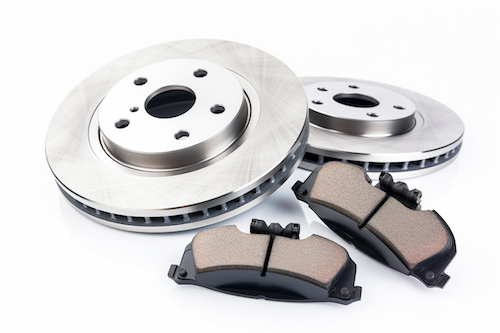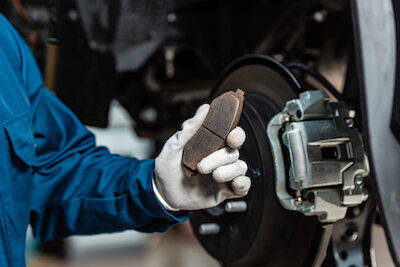Brake Pad Replacement: A Complete Guide to Types, Maintenance, and Repair

Understanding how your car’s components work can feel overwhelming at first. But knowing the basics is essential for every driver. One of the most important parts to be familiar with is your brake pads. These small but vital pieces play a huge role in keeping you safe on the road.
This guide covers everything you need to know about brake pads, from the different types available to how to tell when it's time for a replacement. You'll also learn about their lifespan, maintenance tips, and how to keep them in good condition for as long as possible.
The Critical Role of Brake Pads in Vehicle Safety
When it comes to vehicle safety, few parts are as important as your brake pads. Think of them as the unsung heroes of your braking system—they're the first line of defense against accidents. These small but powerful components ensure that your brakes function properly when you need them most.
When you press the brake pedal, the brake pads push against the rotors, creating friction that slows down your vehicle. This friction converts kinetic energy into heat, allowing your car to stop safely. Without well-maintained brake pads, this process would fail, putting you and others at risk.
Why High-Quality Brake Pads Matter
Now that you understand what brake pads do, it's clear why choosing high-quality ones is so important. The right pads can significantly impact your driving experience and overall safety. Here’s why:
- Improved Stopping Power: High-quality pads offer better braking performance, which can be crucial in emergency situations.
- Durability: Cheaper options wear out faster, leading to more frequent replacements and potential safety issues.
- Less Noise and Vibration: Premium pads are designed to reduce squeaking or grinding sounds during braking.
- Longer Lifespan: Although they may cost more upfront, quality pads last longer, saving you money over time.
- Compatibility: They’re made to fit your specific vehicle model, ensuring optimal performance.
Understanding the Different Types of Brake Pads
Brake pads are essential for stopping your car efficiently. When it's time to replace them, knowing the different types available can help you make an informed decision. There are three main types: semi-metallic, ceramic, and organic.
Semi-Metallic Brake Pads
These are the most common type and are made from a mix of metal fibers (like steel or copper) and organic materials. They offer strong braking performance and are suitable for a wide range of vehicles, including trucks and sedans.
They are durable and handle heat well, making them ideal for heavy-duty use. However, they can be noisier and produce more dust than other types.
Ceramic Brake Pads
Ceramic pads are known for their superior performance and longevity. Made from ceramic fibers and bonding agents, they provide smooth braking with minimal noise and dust. They are resistant to brake fade and are great for high-performance cars.
While they tend to be more expensive, they often last longer and require fewer replacements, making them a cost-effective choice in the long run.
Organic Brake Pads
Also known as non-asbestos organic pads, these are made from natural materials like rubber, glass, and Kevlar. They are typically the most affordable option and offer a quiet, smooth braking experience.
They perform well across a range of temperatures and generate less dust. However, they don’t last as long as other types and aren’t ideal for high-performance or heavy-duty driving.
Always check your vehicle manual and consider your driving style when selecting the best type of brake pads for your car.
When Should You Replace Your Brake Pads?
Brake pads are designed to wear down over time, and ignoring this can compromise your safety. It's important to know when to replace them before they become a serious issue.
Mileage Guidelines
A general rule is to have your brake pads replaced between 25,000 and 70,000 miles, depending on your driving habits and the type of pads you use. Always refer to your owner's manual for manufacturer recommendations.
Wear Indicators
Many modern brake pads come with wear indicators—small metal tabs that make noise when the pads are worn out. If you hear a high-pitched squeal when braking, it's a sign that it's time for a replacement.
Signs That You Need New Brake Pads
There are several signs that indicate your brake pads might be worn out. If you notice any of these, it’s time to get them checked:
Vibrations in the Brake Pedal
If you feel a vibration or pulsation when pressing the brake pedal, it could mean uneven pad wear or deposits on the rotor. This can lead to inconsistent braking and should be addressed immediately.
Vehicle Pulling to One Side
If your car pulls to one side when braking, it may be due to uneven pad wear. This can affect handling and increase the risk of an accident.
Reduced Braking Performance
If you find yourself pressing the brake pedal harder or if your car takes longer to stop, it could be a sign that your brake pads are worn out.
Decreased Braking Performance
If you've noticed that your vehicle takes longer to stop, your brake pads may be worn out. As they lose their grip on the rotors, braking efficiency decreases. This can be a sign that it's time for a replacement.

By being attentive to these signs, you can maintain a safe and reliable braking system. Early detection and timely replacement can prevent costly damage and ensure your vehicle remains safe on the road.
Key Factors to Consider When Choosing Brake Pads
Choosing the right brake pads involves more than just picking the cheapest option. Here are three important factors to keep in mind:
Vehicle Compatibility
Not all brake pads are suitable for every car. Make sure the pads you choose are specifically designed for your vehicle model. This ensures proper fit and performance.
Your Driving Style
Your driving habits will influence which type of brake pads are best for you. For example, if you drive aggressively or frequently in urban areas, semi-metallic pads may be a good choice.
Climate Conditions
Extreme weather can affect brake performance. If you live in a hot climate, look for pads that resist heat fade. In colder or wet conditions, choose pads with good wet-weather traction.
Considering these factors will help you select the best brake pads for your needs and driving environment.
Tips to Extend the Life of Your Brake Pads
To maximize the lifespan of your brake pads and keep your braking system in top shape, follow these simple tips:
Regular Inspections
Check your brake pads regularly through the wheel spokes. If they're less than 1/4 inch thick, they need to be replaced. Listen for unusual noises, like squeaking or grinding, which may indicate wear.
Gentle Braking
Avoid sudden stops. Instead, brake gradually to reduce stress on your pads and improve fuel efficiency.
Reduce Weight
Keep your car light by removing unnecessary items from the trunk or backseat. Less weight means less strain on your braking system.
Maintain Safe Distance
Keeping a safe distance from the car in front of you helps avoid sudden braking, which can wear down your pads faster.
Check Brake Fluid
Low brake fluid can affect performance. Check the level regularly and top it off as needed.
Professional Maintenance
Have a qualified mechanic inspect your brakes periodically. They can catch issues early and make necessary adjustments for even pad wear.
With regular care, your brake pads can last longer and your braking system will remain reliable and safe.
Lamb’s Tire & Automotive – Your Trusted Austin Brake Repair Experts
Brake pads are a critical part of your vehicle's safety. With the knowledge provided in this guide, you can take control of your brake maintenance and ensure your car stays in excellent condition.
If you're looking for professional and trustworthy brake services in Austin, Lamb’s Tire & Automotive is the place to go. Our ASE-certified technicians offer a full range of brake repair and maintenance services, from pad replacements to fluid flushes. We use high-quality parts and advanced tools to deliver top-notch performance and reliability for your vehicle's braking system.
Fibc Bag,Fibc Bags,Bulk Bag Fibc Bag,Sling Fibc Bag
Zhejiang Changying Plastic Packaging Products Co., Ltd. , https://www.cyfibc.com